Experimental Study of the Free Space Optics Communication System Operating in the 8–12 µm Spectral Range
Abstract
1. Introduction
2. Materials and Methods
3. Results
4. Discussion
Author Contributions
Funding
Acknowledgments
Conflicts of Interest
References
- Kumar, N.; Kumar Rana, A. Impact of various parameters on the performance of free space optics communication system. Optik 2013, 124, 5774–5776. [Google Scholar] [CrossRef]
- Majumdar, A.K.; Ricklin, J.C. Free-Space Laser Communications: Principles and Advances 5–10; Springer: Berlin/Heidelberg, Germany, 2010. [Google Scholar]
- Vigneshwaran, S.; Muthumani, I.; Raja, A.S. Investigations on Free Space Optics Communication System. In Proceedings of the International Conference on Information Communication & Embedded Systems (ICICES ‘13) IEEE, Chennai, India, 21–22 February 2013; pp. 819–824. [Google Scholar]
- Sharma, V.; Kaur, G. High speed, long reach OFDM-FSO transmission link incorporating OSSB and OTSB schemes. Optik 2013, 124, 6111–6114. [Google Scholar] [CrossRef]
- Andrews, L.; Phillips, R.L.; Hopen, C.Y. Laser Beam Scintillation with Applications; SPIE Press: Bellingham, WA, USA, 2001. [Google Scholar]
- Shaulov, G.; Patel, J.; Whitlock, B.; Mena, P.; Scarmozzino, R. Simulation-Assisted Design of Free Space Optical Transmission Systems. In Proceedings of the Military Communications Conference (MILCOM ‘05), Atlantic City, NJ, USA, 2 October 2005; pp. 918–922. [Google Scholar]
- Willebrand, H.A.; Ghuman, B.S. Fiber optics without fiber. IEEE Spectr. 2001, 38, 40–45. [Google Scholar] [CrossRef]
- Korai, U.A.; Luini, L.; Nebuloni, R. Model for the Prediction of Rain Attenuation Affecting Free Space Optical Links. Electronics 2018, 7, 407. [Google Scholar] [CrossRef]
- Touati, A.; Abdaoui, A.; Touati, F.; Uysal, M.; Bouallegue, A. On the Effects of Temperature on the Performances of FSO Transmission under Qatar’s Climate. In Proceedings of the 2017 IEEE 85th Vehicular Technology Conference (VTC Spring), Sydney, Australia, 4–7 June 2017. [Google Scholar]
- Mushtaq, T.; Yasir, S.; Khan, M.; Wahid, A.; Iqbal, M. Analysis of Internal Design Parameters to Minimize Geometrical Losses in Free-Space Optical Communication Link. Acta Phys. Polonica A 2018, 134, 275–277. [Google Scholar] [CrossRef]
- Singh, J.; Kumar, N. Performance analysis of different modulation format on free space optical communication system. Optik 2013, 124, 4651–4654. [Google Scholar] [CrossRef]
- Bag, B.; Das, A.; Chandra, A.; Róka, R. Performance Analysis of FSO Links in Turbulent Atmosphere. In Design, Implementation, and Analysis of Next Generation Optical Networks: Emerging Research and Opportunities Design, Implementation, and Analysis of Next Generation Optical Networks: Emerging Research and Opportunities; IGI Global: Hershey, PA, USA, 2019. [Google Scholar]
- Mazin Ali, A.A.; Sabah Jameel, M. Impact of atmospheric turbulence on the performance of FSO link. J. Coll. Educ. 2016, 3, 101–110. [Google Scholar]
- Motlagh, A.C.; Ahmadi, V.; Ghassemlooy, Z.; Abedi, K. The effect of atmospheric turbulence on the performance of the free space optical communications. In Proceedings of the 6th International Symposium on Communication Systems, Networks and Digital Signal Processing, Graz, Austria, 23–25 July 2008; pp. 540–543. [Google Scholar] [CrossRef]
- Fadhil, H.A.; Amphawan, A.; Shamsuddin, H.A.B.; Thanaa, H.A.; Al-Khafaji, H.M.R.; Aljunid, S.A.; Nasim, A. Optimization of free space optics parameters: An optimumsolution for bad weather conditions. Optik 2013, 124, 3969–3973. [Google Scholar] [CrossRef]
- Garlinska, M.; Pregowska, A.; Masztalerz, K.; Osial, M. From Mirrors to Free-Space Optical Communication—Historical Aspects in Data Transmission. Future Internet 2020, 12, 179. [Google Scholar] [CrossRef]
- Alkholidi, A.G.; Altowij, K.S. Free Space Optical Communications—Theory and Practices. In Contemporary Issues in Wireless Communications; InTech: London, UK, 2014. [Google Scholar]
- Bouchet, O.; Sizun, H.; Boisrobert, C.; de Fornel, F.; Favennec, P. Free-Space Optics Propagation and Communication; ISTE Ltd.: London, UK, 2006. [Google Scholar]
- Pecharromán-Gallego, R. An Overview on Quantum Cascade Lasers: Origins and Development, Quantum Cascade Lasers; IntechOpen: London, UK, 2016. [Google Scholar]
- Rothman, J.; Bleuet, P.; Abergel, J.; Gout, S.; Lasfargues, G.; Mathieu, L.; Nicolas, J.A.; Rostaing, J.P.; Huet, S.; Castelein, P.; et al. HgCdTe APDs detector developments at CEA/Leti for atmospheric lidar and free space optical communications. In Proceedings of the SPIE 11180, International Conference on Space Optics—ICSO 2018, Crete, Greece, 9–12 October 2019; p. 111803S. [Google Scholar]
- Achour, M. Free-Space Optics Wavelength Selection: 10 μm Versus Shorter Wavelengths. In Proceedings of the Free-Space Laser Communication and Active Laser Illumination III. (2004) Event: Optical Science and Technology, SPIE’s 48th Annual Meeting, San Diego, CA, USA, 4–6 August 2003; Volume 5160. [Google Scholar]
- Gutowska, M.; Pierścińska, D.; Nowakowski, M.; Pierściński, K.; Szabra, D.; Mikołajczyk, J.; Wojtas, J.; Bielecki, Z. Transmitter for free space optics communication system. Bull. Pol. Acad. Sci. Tech. Sci. 2011, 59, 419–423. [Google Scholar]
- Gutowska, M.; Nowakowski, M.; Bielecki, Z.; Mikołajczyk, J.; Szabra, D.; Paliwoda, R.; Pedzinska, D.; Pawluczyk, J.; Gawron, W. Investigation of Free Space Optical Detection Module Operating at the Wavelength Range of 8–12 µm. Acta Phys. Pol. A 2010, 118, 1143–11467. [Google Scholar] [CrossRef]
- Gutowska, M.; Gawron, W.; Nowakowski, M.; Bielecki, Z.; Mikołajczyk, J. New Detection Modules for Free Space Optics. Phot. Lett. Pol. 2010, 2, 88–90. [Google Scholar] [CrossRef]
- Faist, J.; Capasso, F.; Sivco, D.L.; Sirtori, C.; Hutchinson, A.L.; Cho, A.Y. Quantum Cascade Laser. Science 1994, 264, 553–556. [Google Scholar] [CrossRef]
- Gajić, A.; Radovanović, J.; Vuković, N.; Milanović, V.; Boiko, D.L. Theoretical approach to quantum cascade micro-laser broadband multimode emission in strong magnetic fields. Phys. Lett. A 2021, 387, 127007. [Google Scholar] [CrossRef]
- Breed, G. Bit Error Rate: Fundamental Concepts and measurement issues. High Frequency Electronics. Summittechnical Media LLC 2003, 2, 46–48. [Google Scholar]
- van Hemmen, J.L.; Sejnowski, T. 23 Problems in Systems Neurosciences; Oxford University Press: Oxford, UK, 2006. [Google Scholar]
- Kanitscheider, I.; Coen-Cagli, R.; Pouget, A. Origin of information- limiting noise correlations. Proc. Natl. Acad. Sci. USA 2015, 112, e6973–e6982. [Google Scholar] [CrossRef]
- Zhang, M.L.; Qu, H.; Xie, X.R.; Kurths, J. Supervised learning in spiking, neural networks with noise-threshold. Neurocomputing 2017, 219, 333–349. [Google Scholar] [CrossRef]
- Jetka, T.; Nienałtowski, K.; Filippi, S.; Stumpf, M.P.H.; Komorowski, M. An information-theoretic framework for deciphering pleiotropic and noisy biochemical signaling. Nat. Commun. 2018, 9, 1–9. [Google Scholar] [CrossRef] [PubMed]
- Paprocki, B.; Pregowska, A.; Szczepanski, J. Optimizing information processing in brain-inspired neural networks. Bull. Pol. Acad. Sci. Tech. Sci. 2020, 68, 225–233. [Google Scholar]
- Pregowska, A. Signal Fluctuations and the Information Transmission Rates in Binary Communication Channels. Entropy 2021, 23, 92. [Google Scholar] [CrossRef]
- Alpeslasers. Available online: https://www.alpeslasers.ch/ (accessed on 17 March 2021).
- Garlińska, M.; Mikołajczyk, J.; Nowakowski, M.; Bielecki, Z. Badanie wpływu temperatury pracy lasera kaskadowego na jakość transmisji łącza optycznego. Elektron. Konstr. Technol. Zastos. 2013, 54, 39–41. (In Polish) [Google Scholar]
- Nowakowski, M.; Gutowska, M.; Szabra, D.; Mikołajczyk, J.; Wojtas, J.; Bielecki, Z. Investigations of Quantum Cascade Lasers for Free Space Optics Operating at the Wavelength Range of 8–12 μm. Acta Phys. Pol. Ser. A 2011, 120, 705–708. [Google Scholar] [CrossRef]
- DPOJET Jitter and Eye Diagram Analysis Tools Online Help Part Number, 076-0114-13, 27 September 2012. Available online: www.tek.com (accessed on 17 March 2021).
- Garlińska, M. Analiza zasięgowa łączy optycznych. Elektron. Konstr. Technol. Zastos. 2014, 55, 50–51. (In Polish) [Google Scholar]
- Andrews, L.C. Field Guide to Atmospheric Optics; SPIE Press: Bellingham, WA, USA, 2004. [Google Scholar]
- Forin, D.M.; Incerti, G.M.; Tosi Beleffi, G.M.; Teixeira, A.L.J.; Costa, L.N.; De Brito Andre, P.S.; Geiger, B.; Leitgeb, F.; Nadeem, F. Free Space Optical Technologies; Intechopen: London, UK, 2010. [Google Scholar]
- Le-Minh, H.; Ghassemlooy, Z.; Ijaz, M.; Rajbhandari, S.; Adebanjo, O.; Ansari, S.; Leitgeb, E. Experimental study of bit error rate of free space optics communications in laboratory controlled turbulence. In Proceedings of the IEEE Globecom Workshopsmiamifl, Miami, FL, USA, 6–10 December 2010; pp. 1072–1076. [Google Scholar]
- Zabidi, S.A.; Khateeb, W.A.; Islam, M.R.; Naji, A.W. The effect of weather on free space optics communication (FSO) under tropical weather conditions and a proposed setup for measurement. In Proceedings of the International Conference on Computer and Communication Engineering (ICCCE 2010), Kuala Lumpur, Malaysia, 11–13 May 2010; pp. 1–5. [Google Scholar]
- D’Amico, M.; Leva, A.; Micheli, B. Free-space optics communication systems: First results from a pilot field-trial in the surrounding area of Milan, Italy. IEEE Microw. Wirel. Compon. Lett. 2003, 13, 305–307. [Google Scholar] [CrossRef]
- Lionis, A.; Peppas, K.; Nistazakis, H.E.; Tsigopoulos, A.D.; Cohn, K. Experimental Performance Analysis of an Optical Communication Channel over Maritime Environment. Electronics 2020, 9, 1109. [Google Scholar] [CrossRef]
- Wang, Y.; Xu, H.; Li, D.; Wang, R.; Jin, C.; Yin, X.Y.; Gao, S.; Mu, Q.; Zuan, L.; Cao, Z. Performance analysis of an adaptive optics system for free-space optics communication through atmospheric turbulence. Sci. Rep. 2018, 8, 1124. [Google Scholar] [CrossRef] [PubMed]
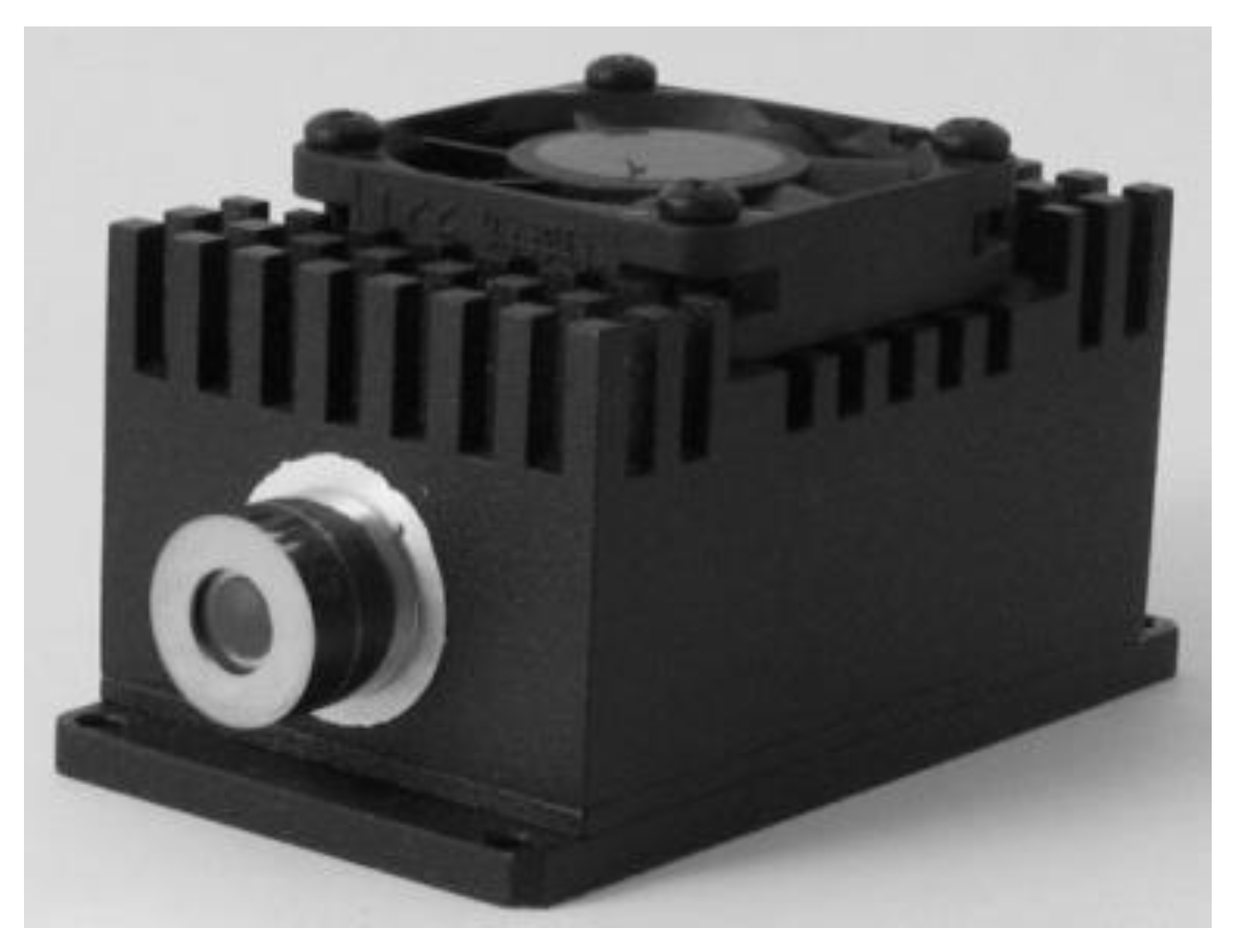

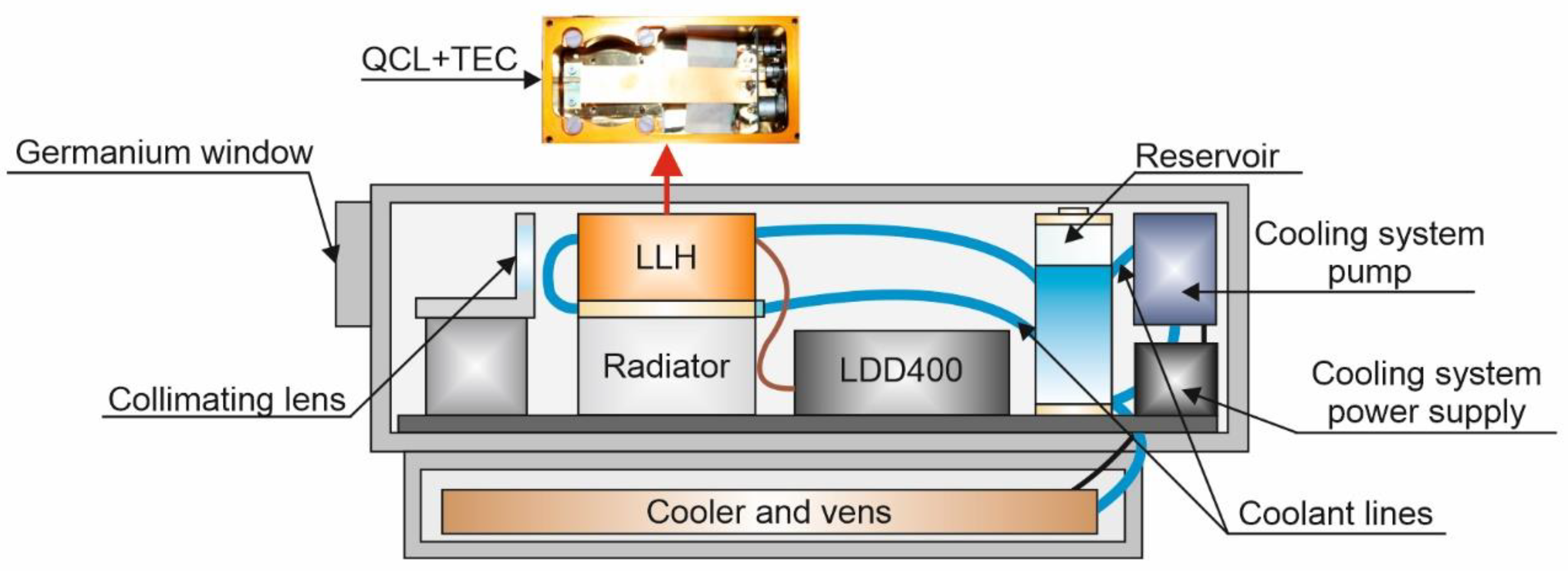
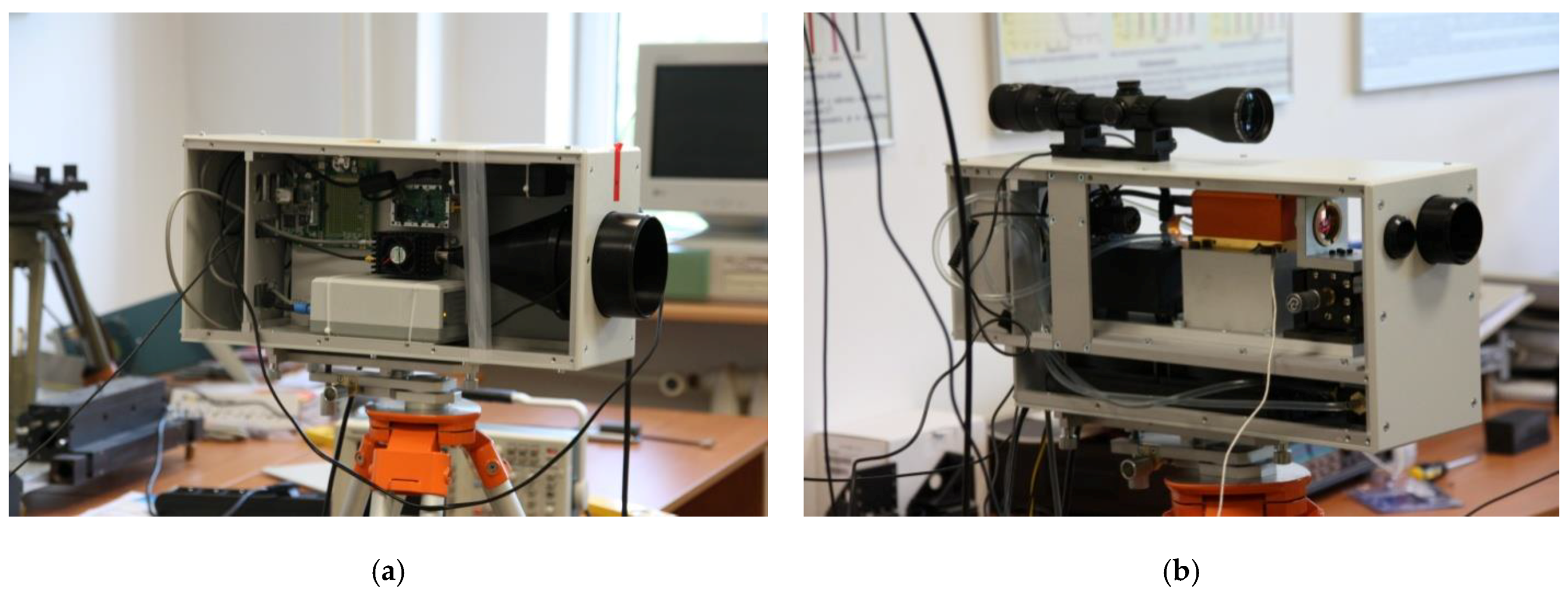
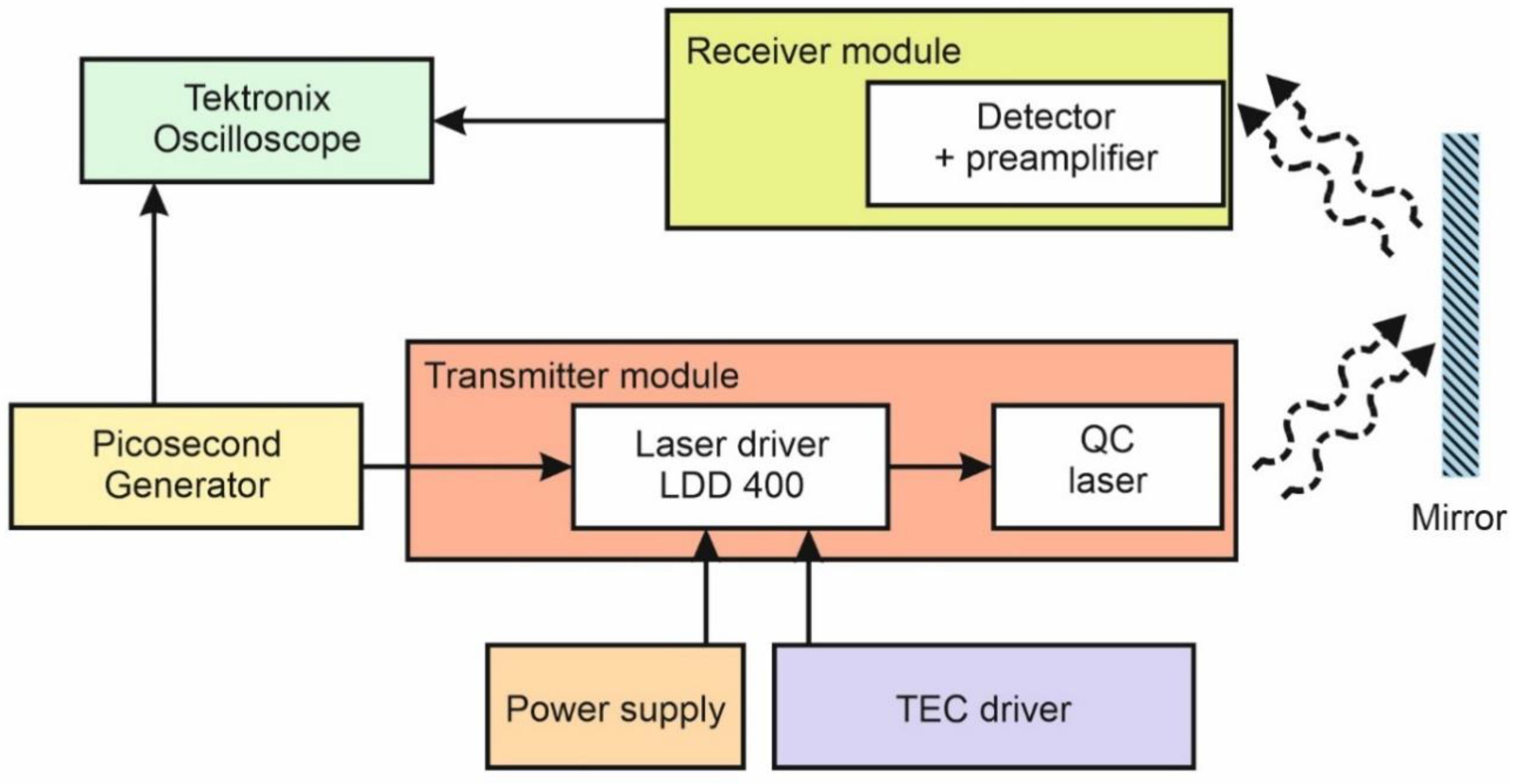
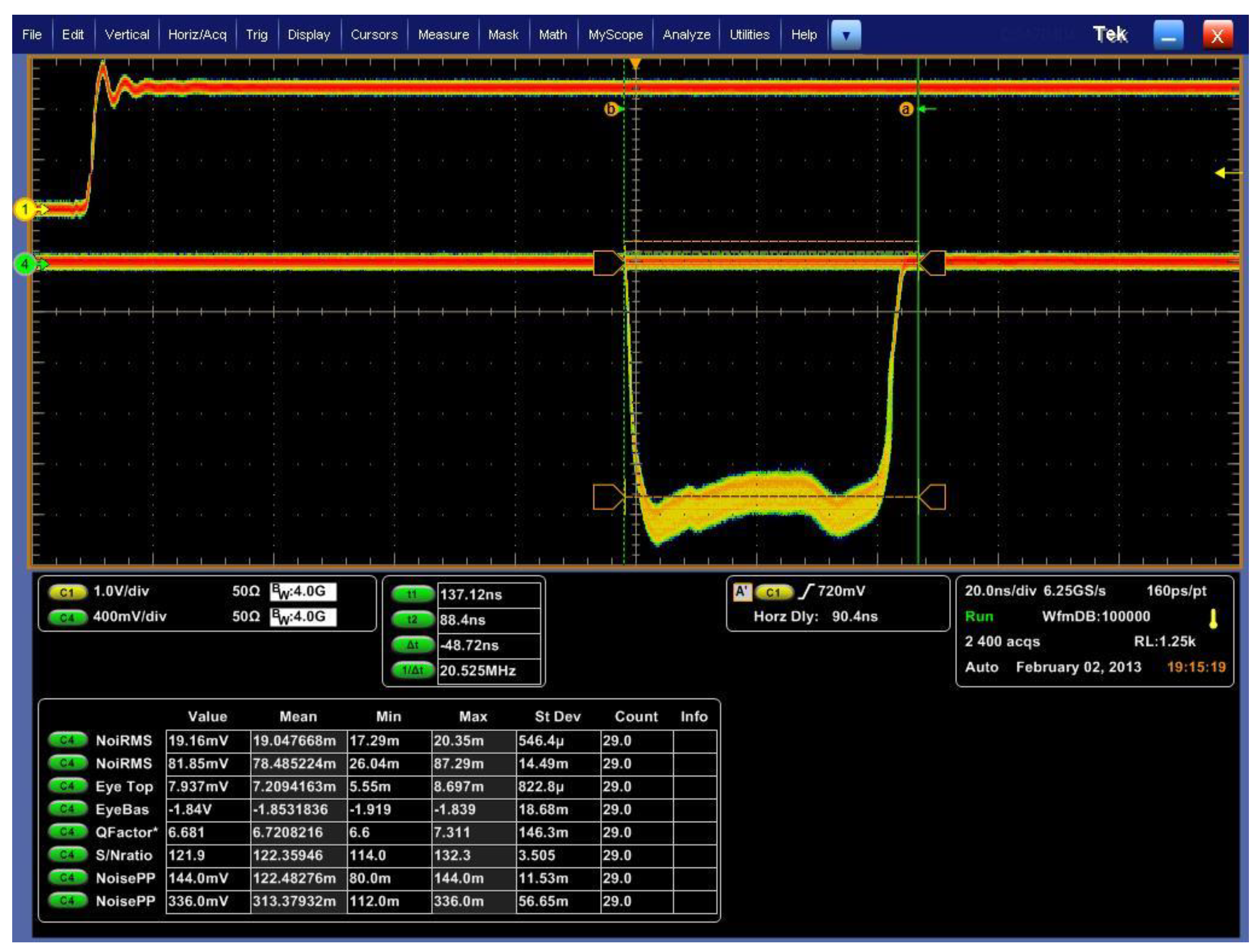
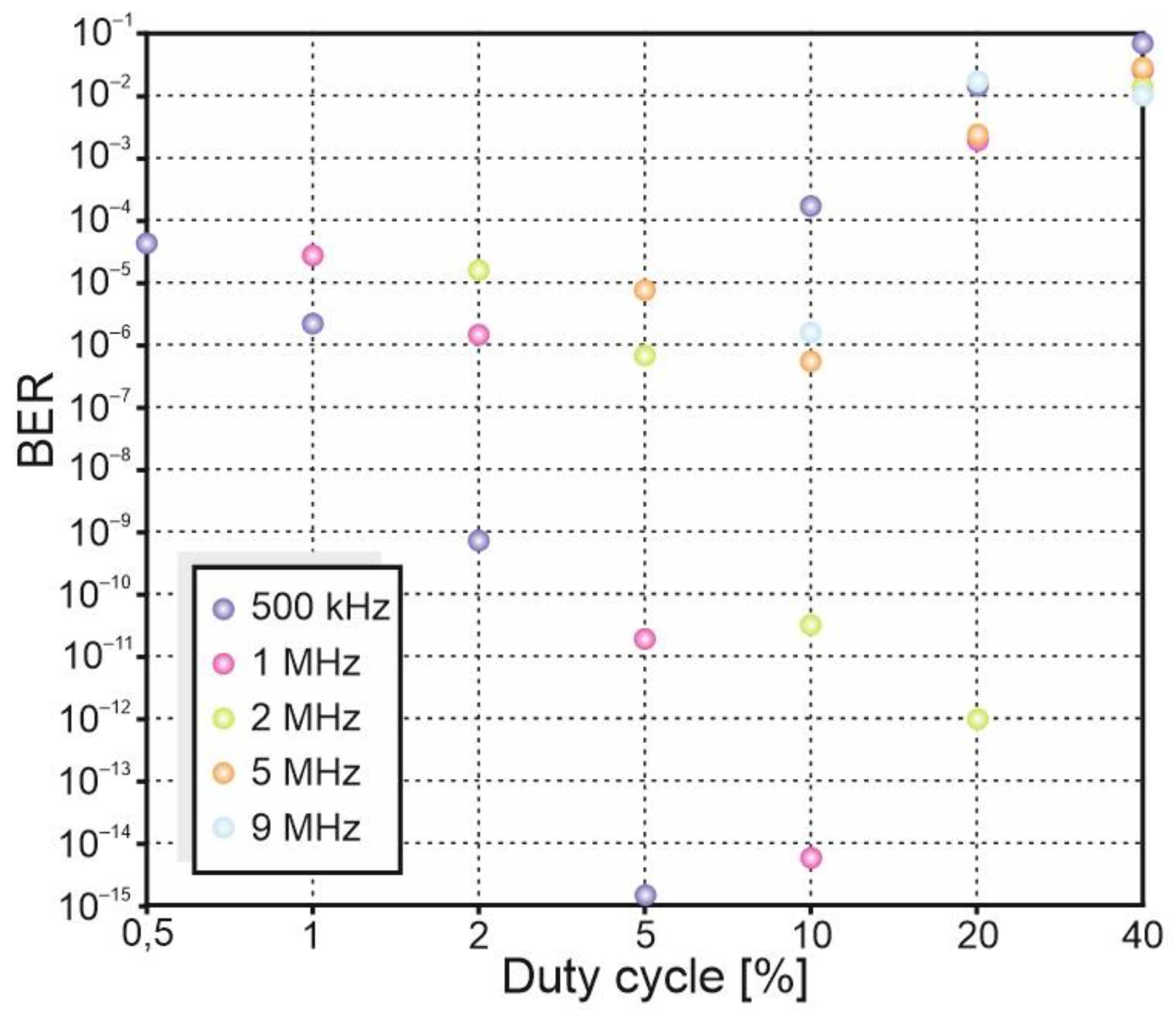
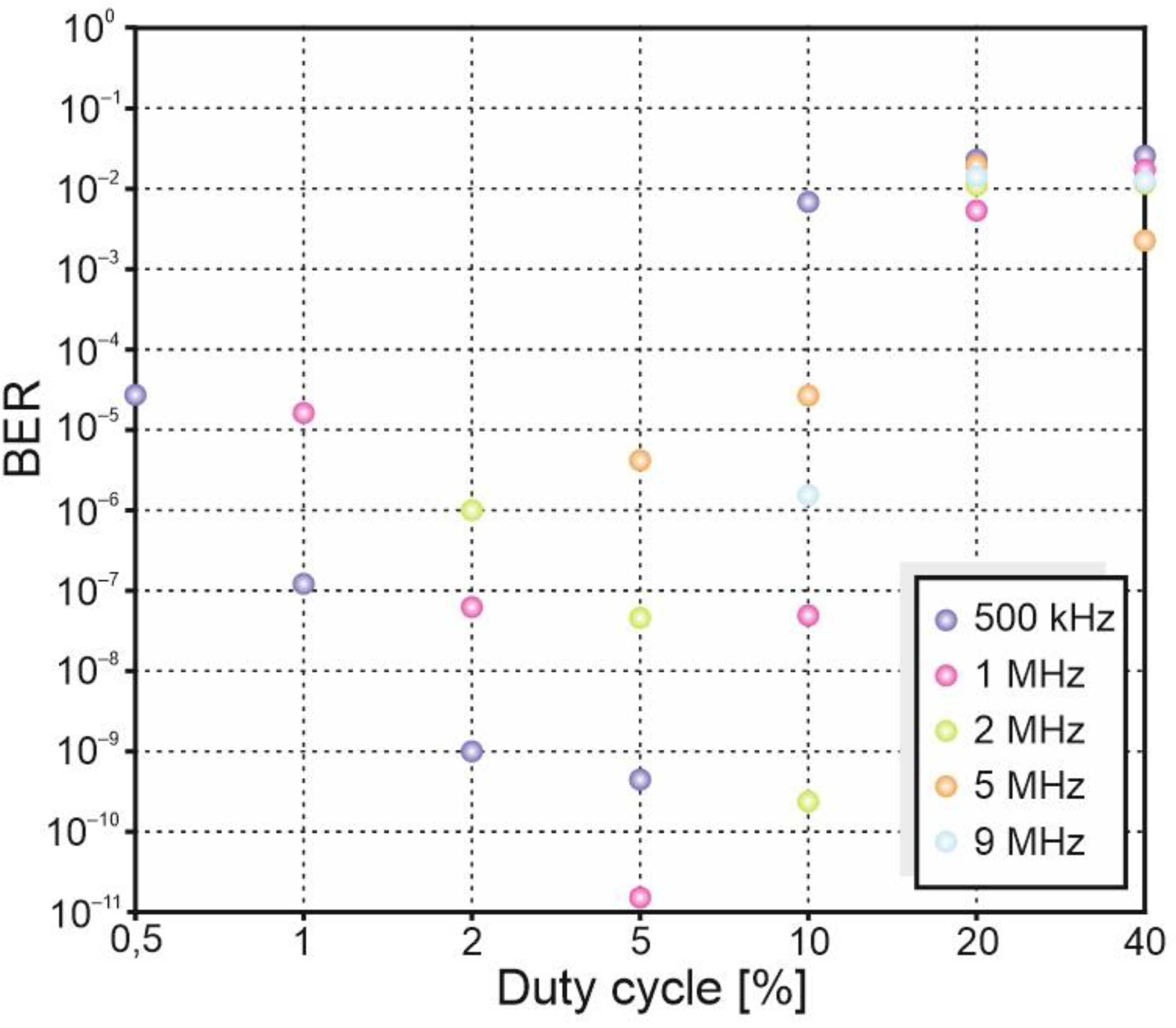
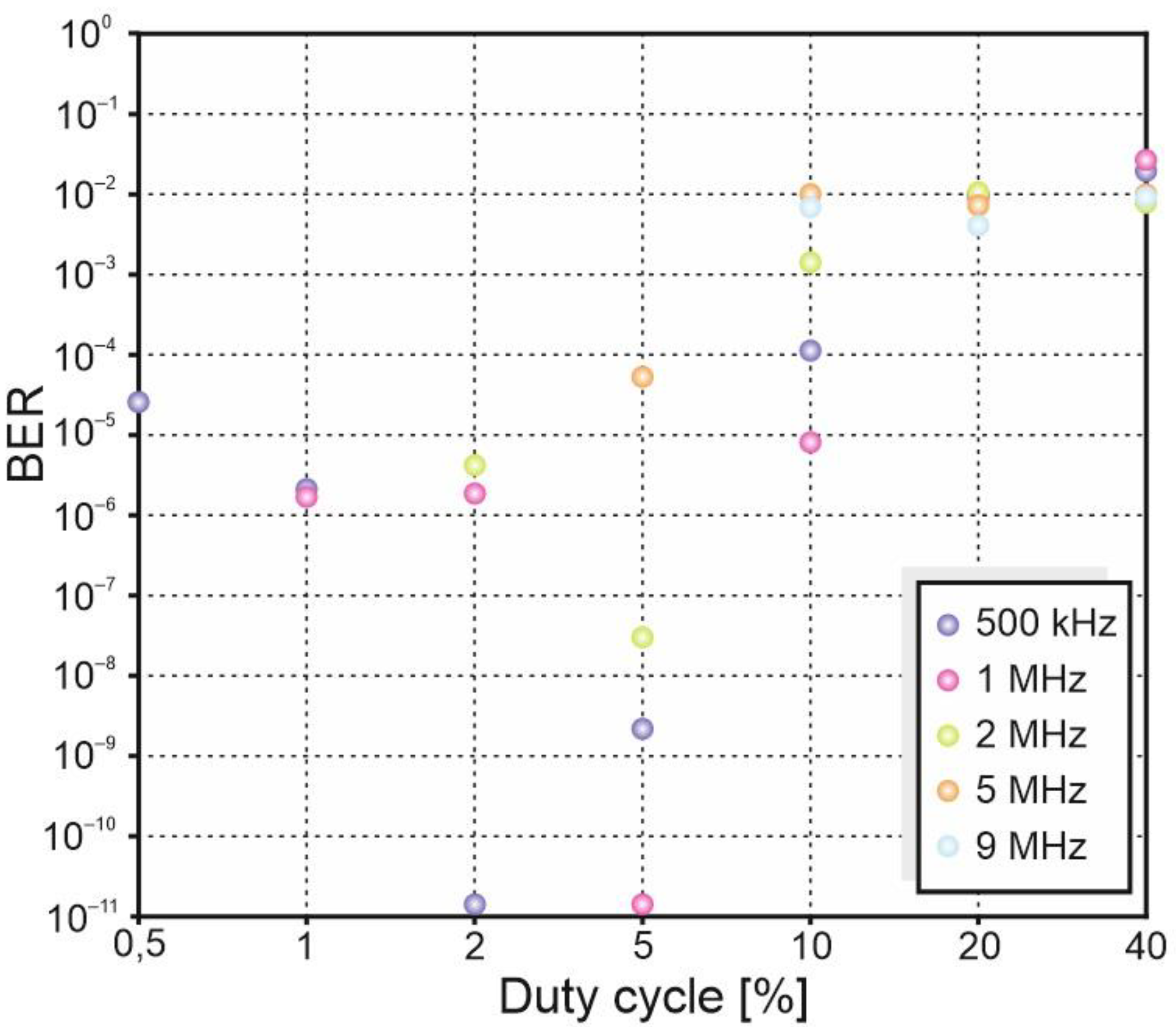


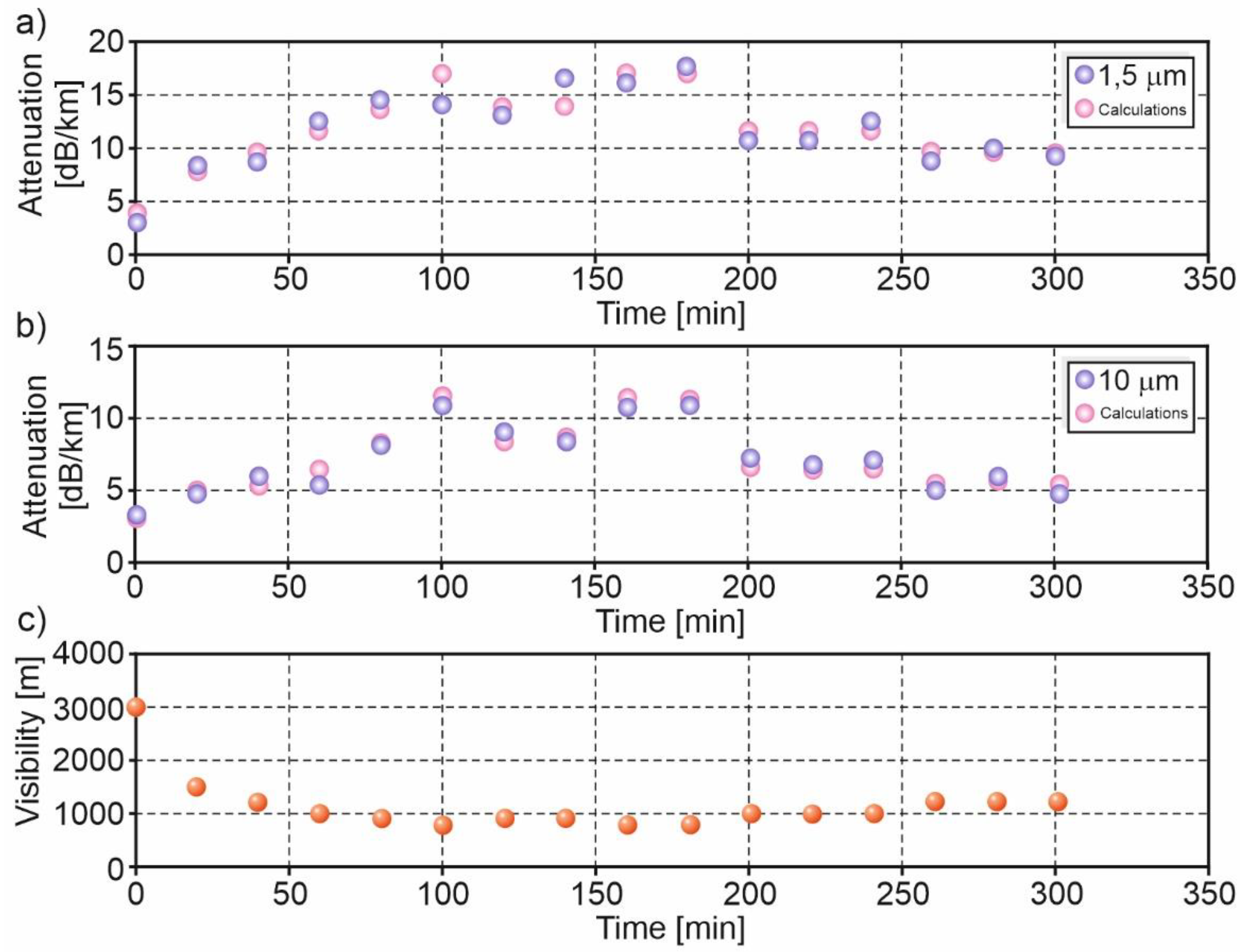
| Parameter | Unit | Value |
|---|---|---|
| Transimpedance @RLOAD = 50 Ω | V/A | 13.5 × 103 |
| Output resistance | Ω | 50 |
| Gain bandwidth | MHz | 0.001÷780 |
| Noise voltage | nV/Hz1/2 | 190 |
| Voltage sensitivity | V/W | 2.1 × 105 |
| Detectivity | cmHz1/2/W | 3 × 1010 |
| Parameter | Value |
|---|---|
| Type of work | Pseudo-random sequence |
| The length of the generated code | 15,000 bits |
| Character length | 14 |
| Code type | RZ (return to zero) |
| Pulse frequency | from 500 kHz to 9.0 MHz |
| Pulse duty cycle | from 0.5% to 40% |
| Operating temperature of the laser | from −10 °C to 20 °C |
| Low-level voltage | 4.5 V |
| High-level voltage | 0 V |
Publisher’s Note: MDPI stays neutral with regard to jurisdictional claims in published maps and institutional affiliations. |
© 2021 by the authors. Licensee MDPI, Basel, Switzerland. This article is an open access article distributed under the terms and conditions of the Creative Commons Attribution (CC BY) license (https://creativecommons.org/licenses/by/4.0/).
Share and Cite
Garlinska, M.; Pregowska, A.; Gutowska, I.; Osial, M.; Szczepanski, J. Experimental Study of the Free Space Optics Communication System Operating in the 8–12 µm Spectral Range. Electronics 2021, 10, 875. https://doi.org/10.3390/electronics10080875
Garlinska M, Pregowska A, Gutowska I, Osial M, Szczepanski J. Experimental Study of the Free Space Optics Communication System Operating in the 8–12 µm Spectral Range. Electronics. 2021; 10(8):875. https://doi.org/10.3390/electronics10080875
Chicago/Turabian StyleGarlinska, Magdalena, Agnieszka Pregowska, Izabela Gutowska, Magdalena Osial, and Janusz Szczepanski. 2021. "Experimental Study of the Free Space Optics Communication System Operating in the 8–12 µm Spectral Range" Electronics 10, no. 8: 875. https://doi.org/10.3390/electronics10080875
APA StyleGarlinska, M., Pregowska, A., Gutowska, I., Osial, M., & Szczepanski, J. (2021). Experimental Study of the Free Space Optics Communication System Operating in the 8–12 µm Spectral Range. Electronics, 10(8), 875. https://doi.org/10.3390/electronics10080875










